The main diseases affecting tomatoes are early blight, late blight, bacterial wilt and Fusarium wilt. The main pests of tomato are mites, whiteflies, leafminers (Tuta absoluta) and thrips.
1. Bacterial wilt (Ralstonia solanacearum)
The disease causes rapid wilting and death of the entire plant without any yellowing or spotting of leaves. Total collapse of the plant usually occurring when temperatures reach 32°C and above. Plant wilts while still green. When the stem of a wilting plant is cut across, the pith has a darkened water-soaked appearance, and on squeezing the cut stem, a white, yellow or greyish, slimy exudate may appear. In later stages of the disease, decay of the pith may cause extensive hollowing of the stem.
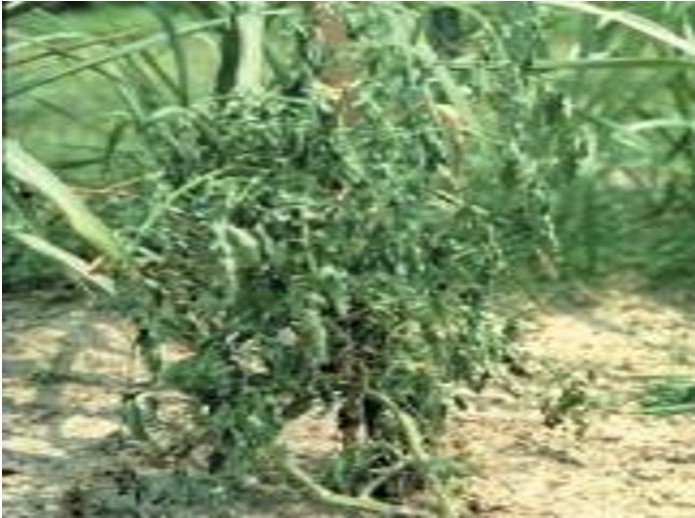
Photo. Tomato plant infested by bacterial wilt
Management:
2. Fusarium wilt (Fusarium oxysporum sp. Lycopersici)
The lower leaves of the plant usually turn yellow and die. One or more branches may exhibit such symptoms. Leaves on one side may be affected while those on the other side are symptomless. Diseased leaves readily break away from the stem. When affected stems just above ground level and petioles are cut diagonally, a reddish-brown discolouration of the water conducting tissues will be observed.
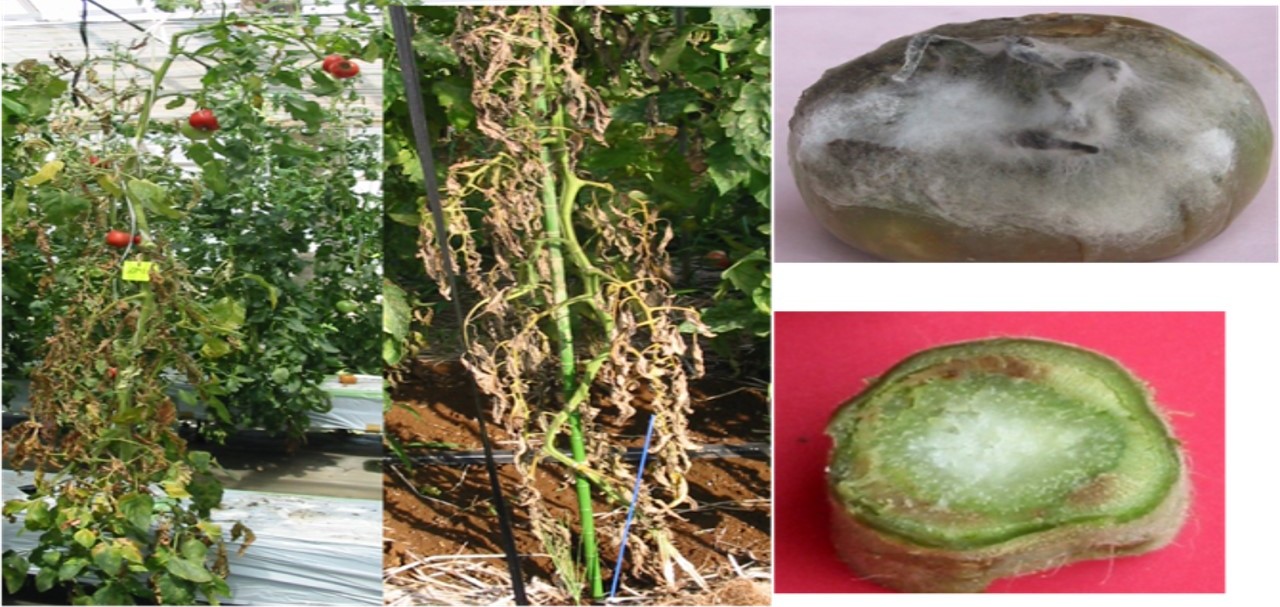
Photos: Symptoms of fusarium wilt on tomato
The fungus is both seed- and soil-borne. It causes most damage on light, sandy soils. It is most active at temperatures between 25 and 320 C. The fungus can survive in the soil indefinitely even when no tomatoes are grown. It can also survive in fibrous roots of weeds (e.g. Amaranthus, Digitaria and Malva species).
Management:
3. Early blight (Alternaria solani)
Leaf spots of early blight are circular, up to 12 mm in diameter, brown, and often show a circular pattern, which distinguishes this disease from other leaf spots on tomato.

Photos: Symptoms of early blight on tomato
Management:
4. Late blight (Phytophthora infestans)
Symptoms of late blight are irregular, greenish-black, water soaked patches, which appear on the leaves. The spots soon turn brown and many of the affected leaves wither, yet frequently remain attached to the stem.
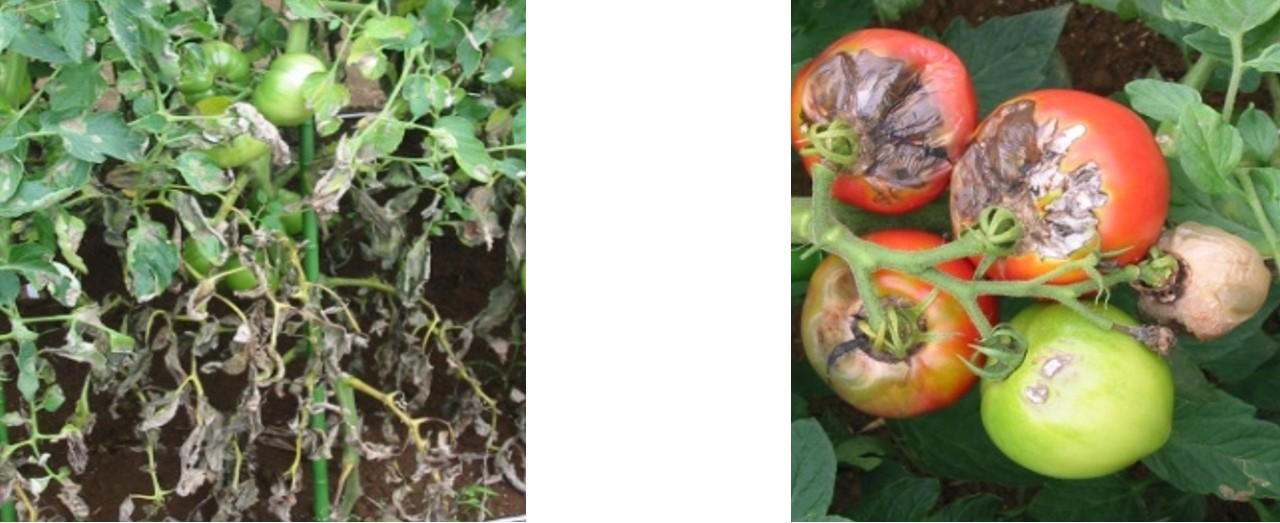
Photo: Late blight symptoms on tomato plant and fruits
Management:
5. Powdery mildew

Photo. Symptoms of powdery mildew on tomato
.6. Blossom end rot (Physiological disorder)

Photo: Stages of blossom end rot
It is caused by calcium deficiency and irregular watering. The disease occurs at the blossom-end of the fruit. It starts as a water-soaked spot that enlarges to become dark brown and sunken. The surface of the spot becomes dark and leathery. The rot is dry.
Management:
7. Tomato viruses
Often spread in the plantation by insect vectors such as whitefly, thrips and aphids. The most important symptom of viral infections is the light (white or yellow) colour of the leaves, or a mosaic pattern of light and darker shades of green on the leaves. In many cases, viral disease leads to dwarfed growth, rosette formation or other strange stem and leaf deformations.
Viruses reported on tomato crop include:
Common control measures include:
7. Major Tomato Pests
The main insects of tomato are red spider mites and russet mites, fruitworms, whiteflies, leafminers and thrips.
7.1. Whiteflies
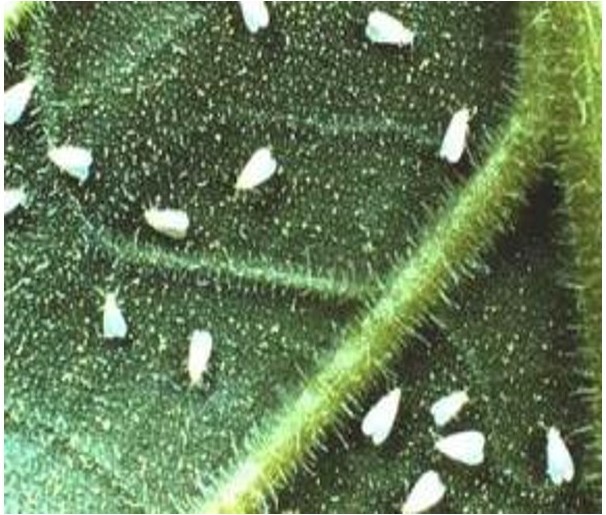
Whiteflies under leaf. Adult whiteflies are about 1mm long.
This whitefly is a serious pest of tomatoes. Whiteflies attack tomatoes from seedling to mature stage. They sucks sap from the leaves, and may weaken the plants. Feeding of whiteflies causes yellowing of infested leaves. However, the main damage caused by whiteflies is indirect as vectors of virus diseases. Bemisia tabaci transmits several virus diseases in tomato. In particular it is an efficient vector of the Tomato Yellow Leaf Curl Virus (TYLCV). Small numbers of whiteflies do not cause major direct plant damage. However, even small numbers of whiteflies may need to be controlled in areas where TYLCV is common.
Management:
7.2. Aphids (Aphis gossypii, Myzus persicae)
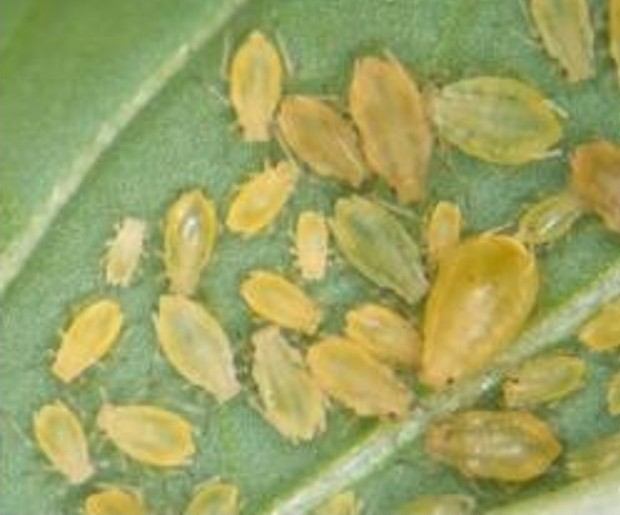
Photo. Green peach aphid (Myzus persicae)
Aphids such as cotton aphid (Aphis gossypii) and the green peach aphid (Myzus persicae) suck plant sap, which can reduce plant growth; they also secrete honeydew, on which sooty moulds growth. Sooty mould on fruits reduces their market value. These aphids may also transmit virus diseases during feeding such as the cucumber mosaic virus.
Management
TUTA Absoluta
It’s a harmful mining moth with a strong preference for tomatoes and other crops in solanacea family.
symptoms:
TUTA Absoluta
Prefers leaves and stems. It also occurs underneath the crown of a fruit and sometimes inside.
Severe infection leads to drying of the leaves and sometimes dying of the whole crop.
Control:
Use of Chemicals; e.g. Emamectin benzoate and Abamectin alternatively for attacking both adult and larva.